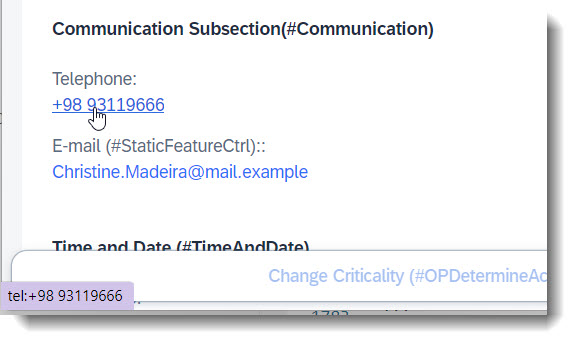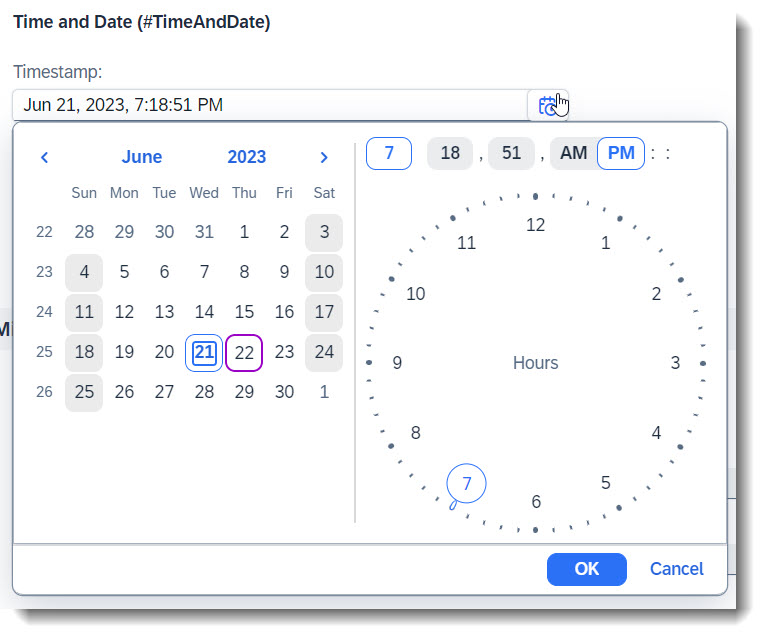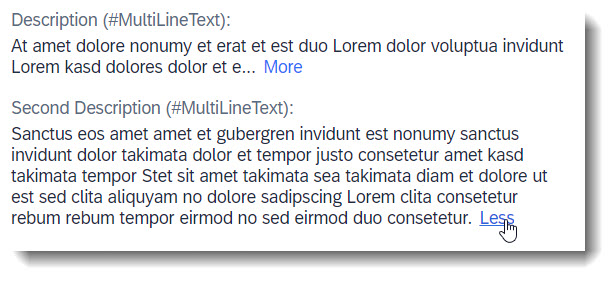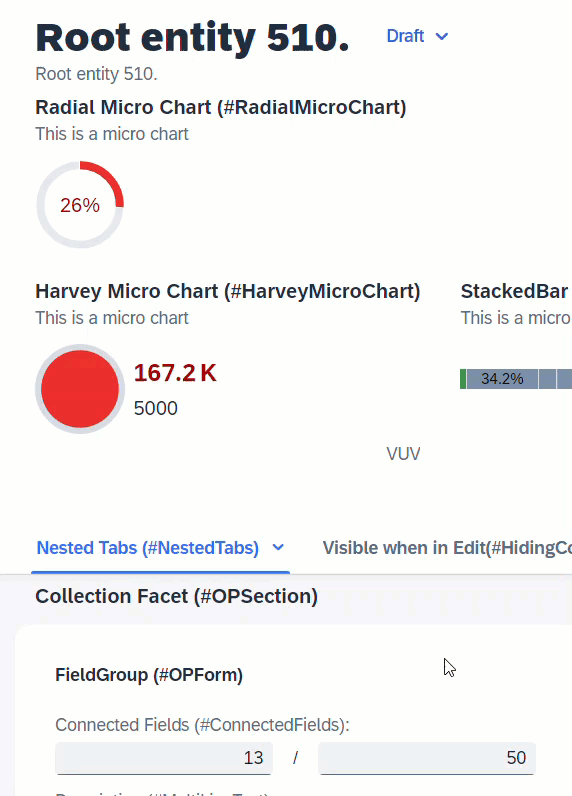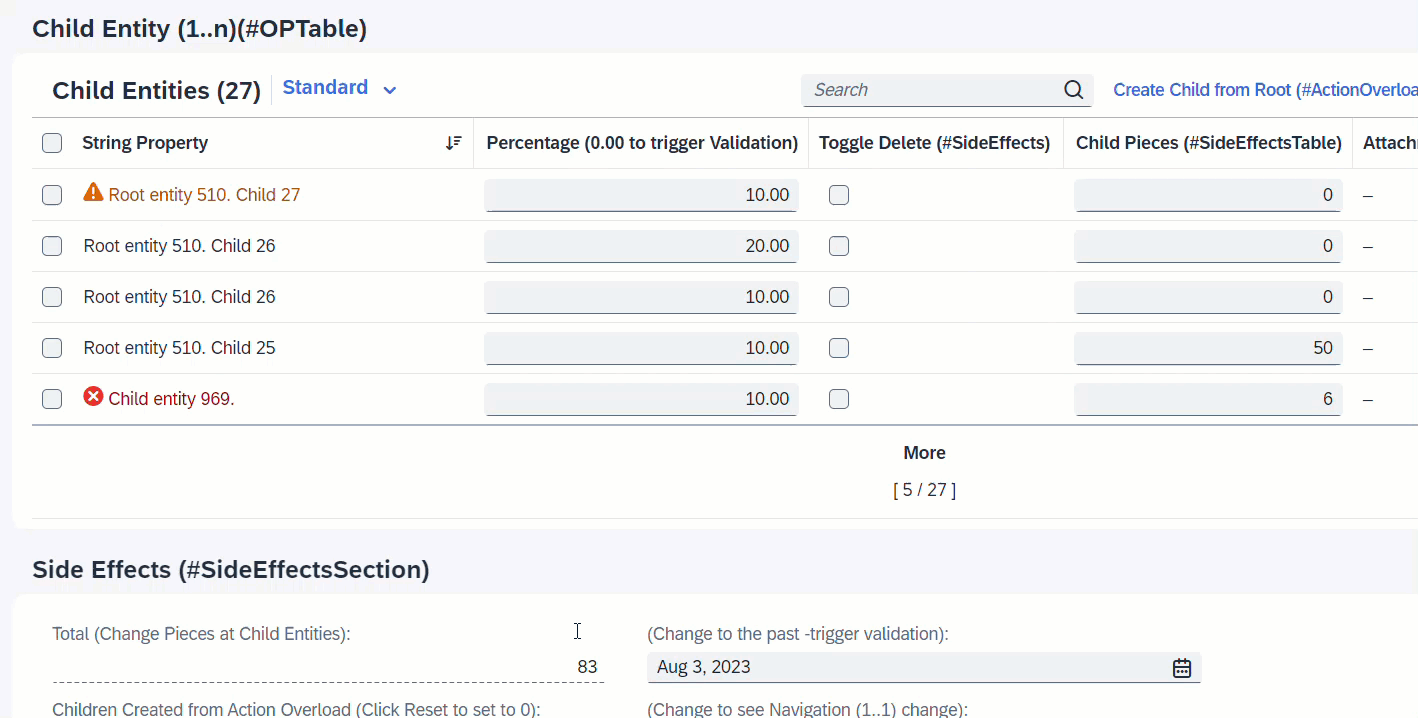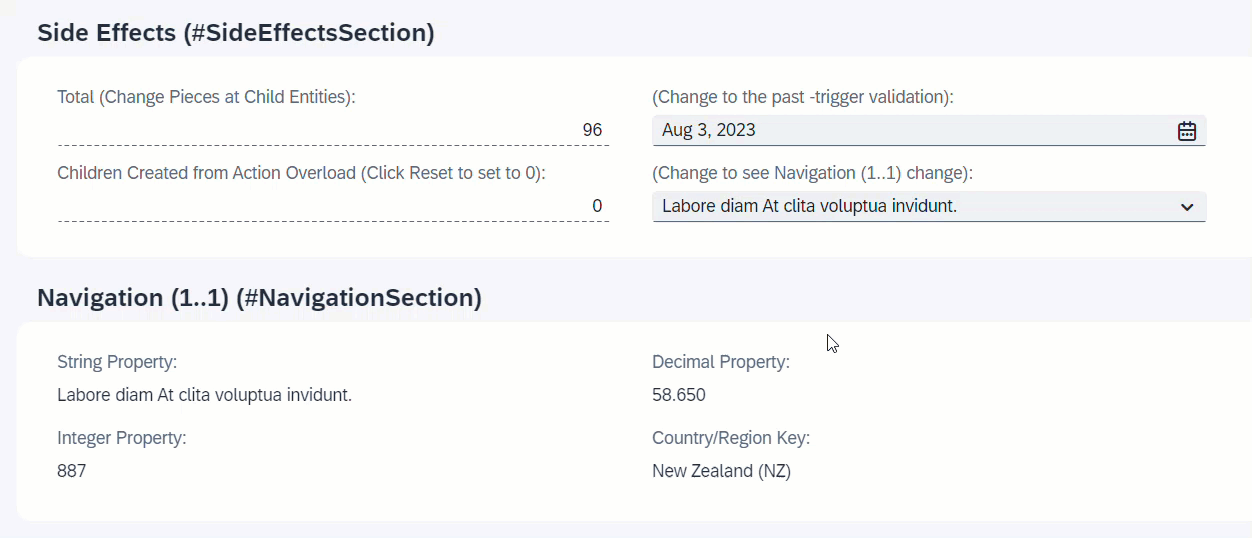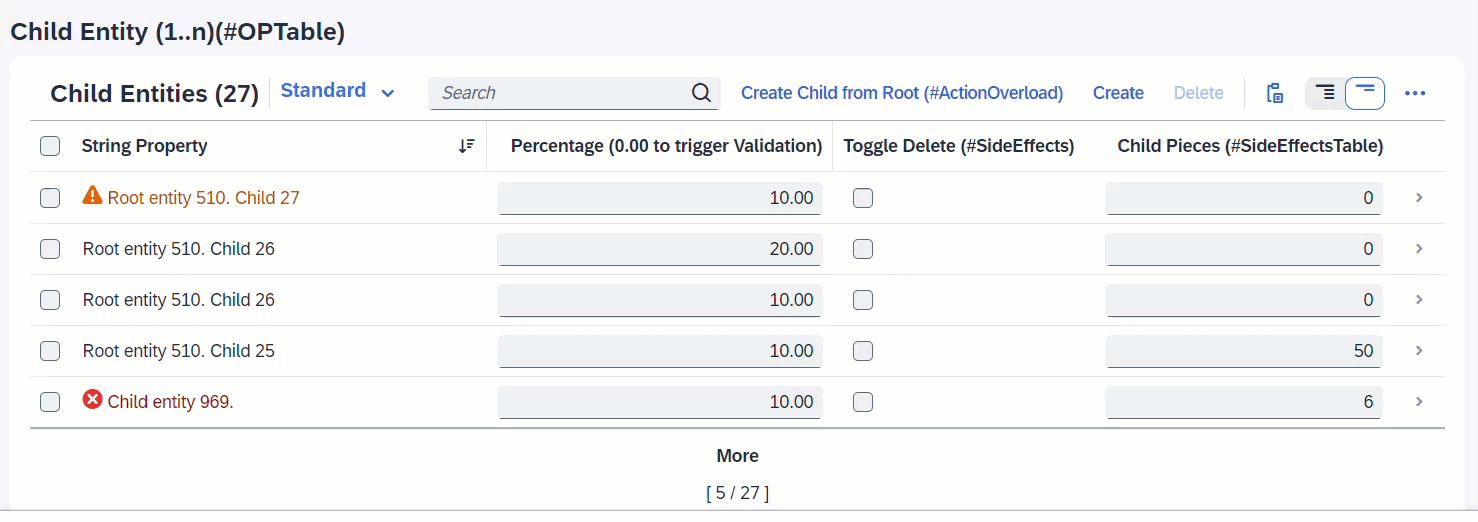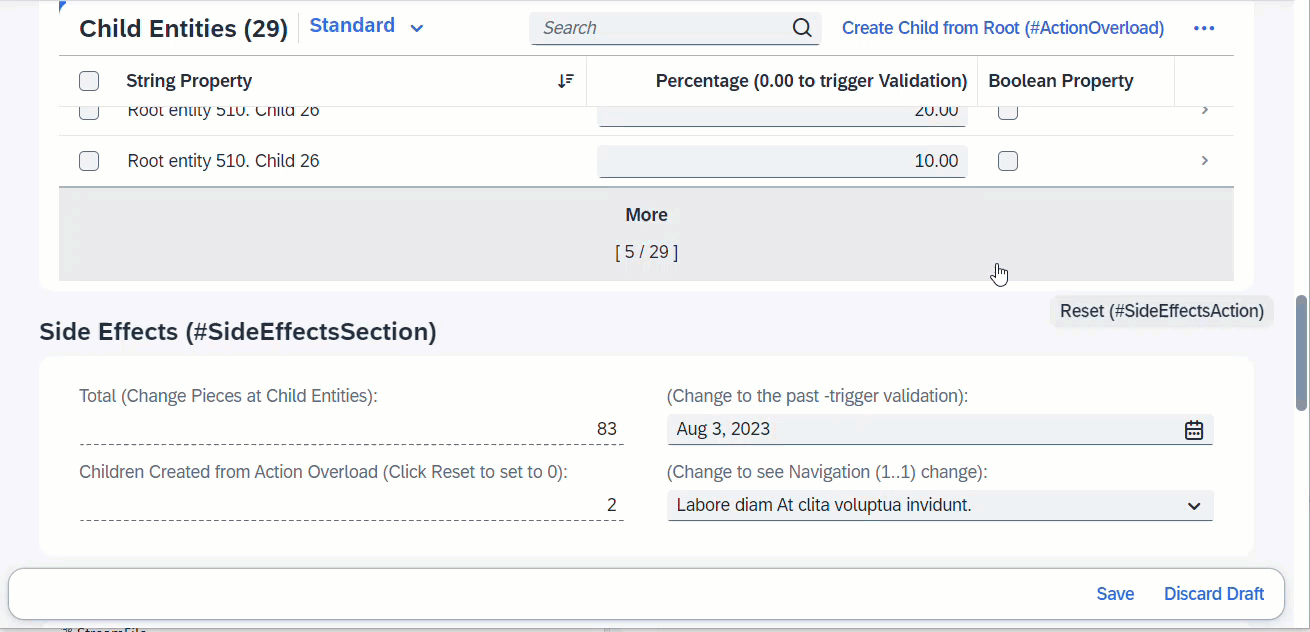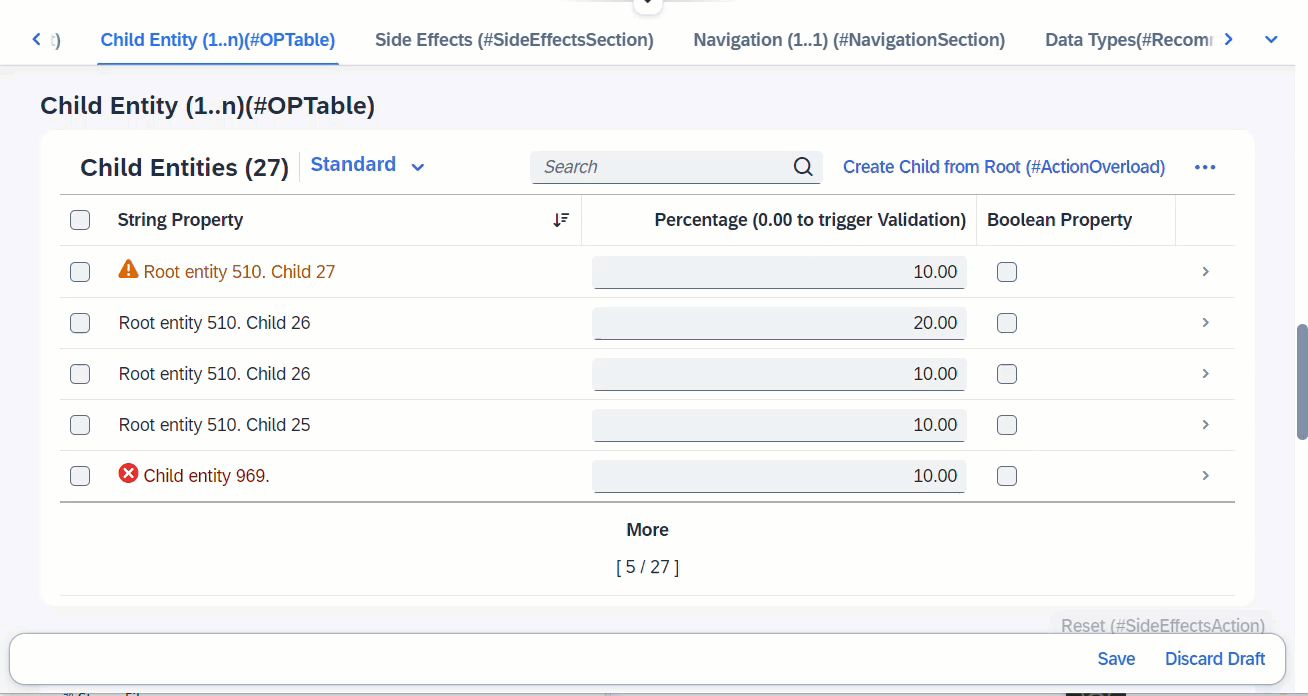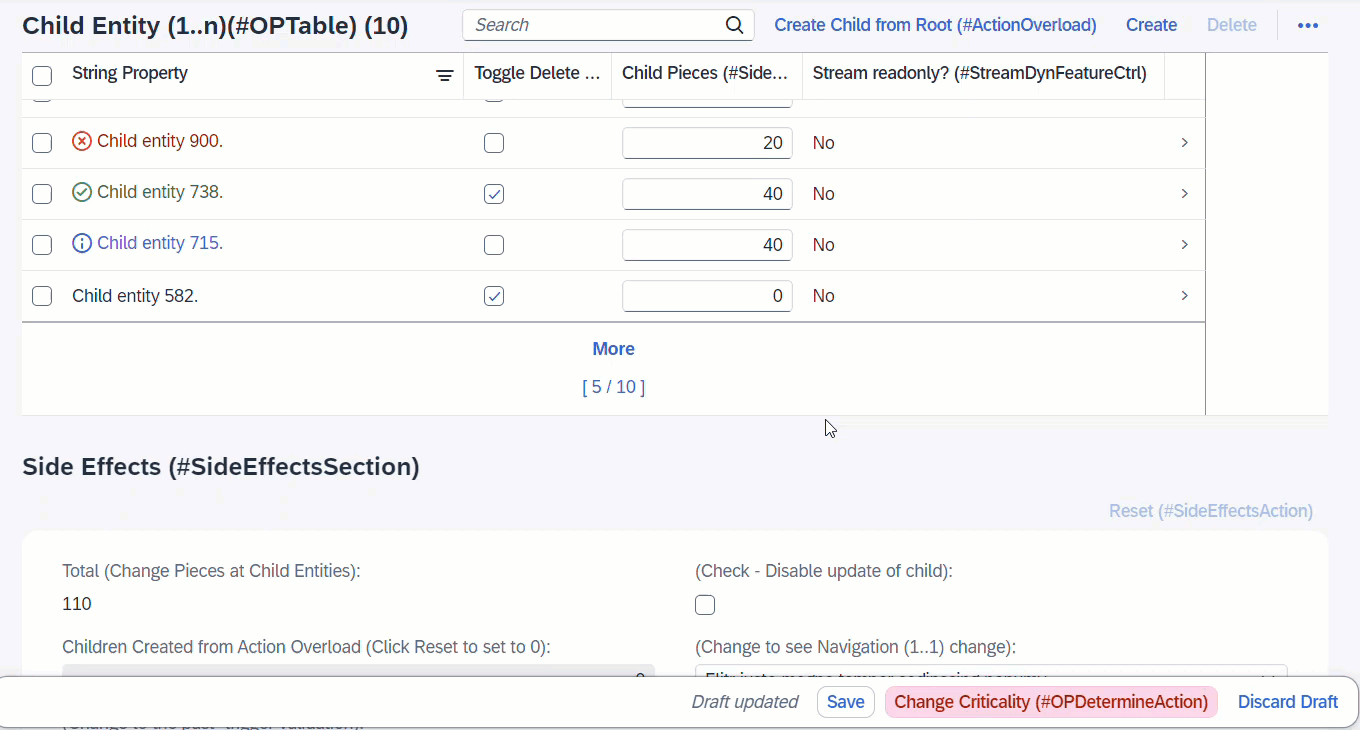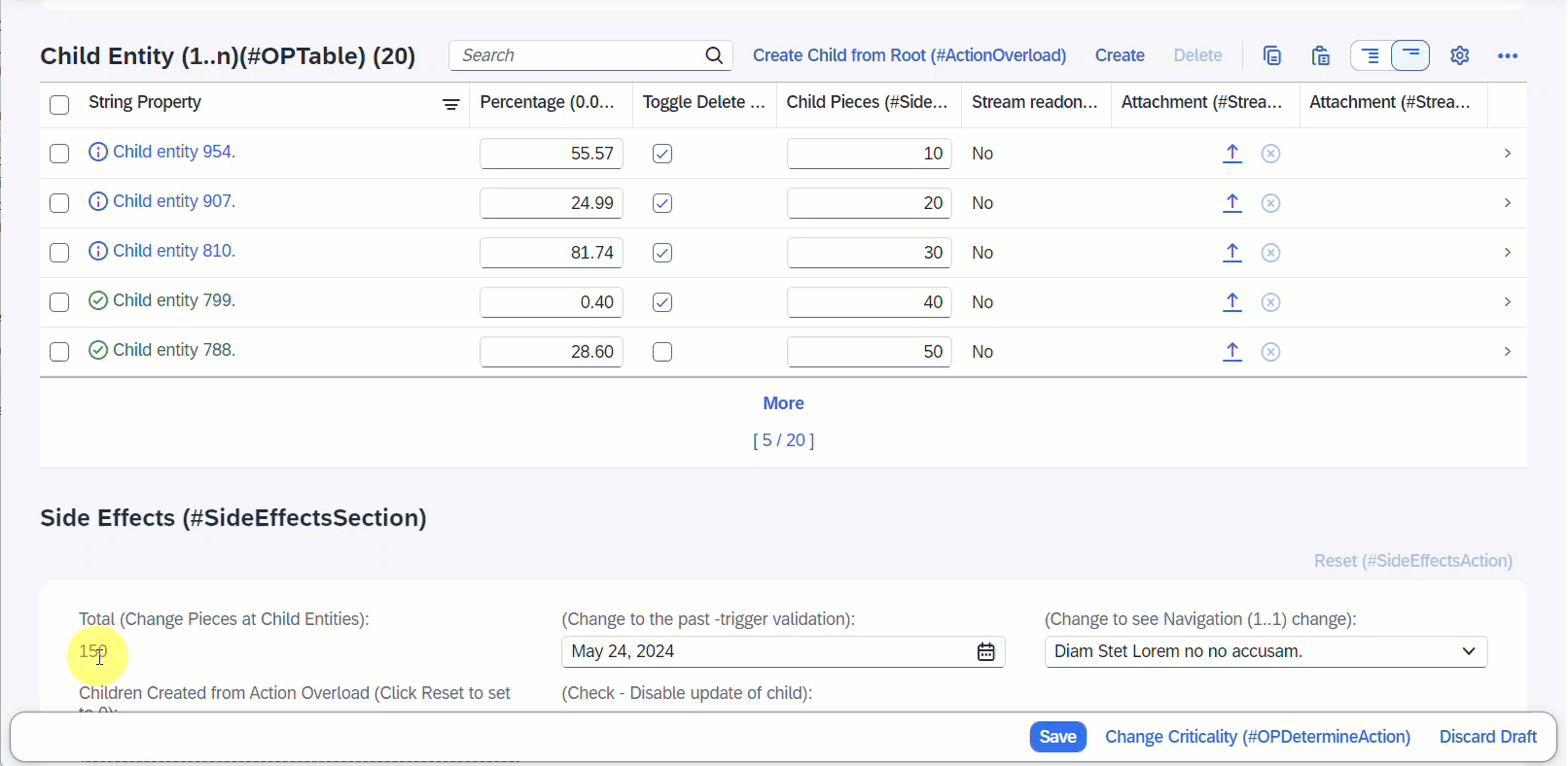Search term: #CommunicationFields
To display emails and phone numbers as a link, they are annotated with @Semantics.email.address: true or @Semantics.telephone.type
Note
Source: CDS View /DMO/FSA_I_Root
// Search Term #CommunicationFields
@Semantics.eMail.address: true
email as Email,
// Search Term #CommunicationFields
@Semantics.telephone.type: [#CELL]
telephone as Telephone,
Note
Source: Metadata Extension /DMO/FSA_C_RootTP
// Search Term #Communication
@UI.facet: [
{
purpose: #HEADER, // or #STANDARD
label : 'Communication Subsection(#Communication)',
type : #FIELDGROUP_REFERENCE,
targetQualifier: 'communication'
}
]
@UI.fieldGroup: [{ qualifier: 'communication' }] // Search Term #Communication
Email;
@UI.fieldGroup: [{ qualifier: 'communication' }] // Search Term #Communication
Telephone;
More Information: ABAP RESTful Application Programming Model - Contact Data
Search term: #TimeAndDate
SAP Fiori Elements provides out of the box support for displaying and editing dates and times, as well as time stamps. No additional annotations are needed, the properties just need to have the corresponding data types.
The following annotations are used in the app, in order to group the time and date fields and show them in a facet.
Note
Source: Metadata Extension /DMO/FSA_C_RootTP
// Search Term #TimeAndDate
@UI.facet: [
{
purpose: #HEADER, // or #STANDARD
label : 'Time and Date (#TimeAndDate)',
type : #FIELDGROUP_REFERENCE,
targetQualifier: 'timeAndDate'
}
]
@UI.fieldGroup: [{ qualifier: 'timeAndDate' }] // Search Term #TimeAndDate
ValidTo;
@UI.fieldGroup: [{ qualifier: 'timeAndDate' }] // Search Term #TimeAndDate
Time;
@UI.fieldGroup: [{ qualifier: 'timeAndDate' }] // Search Term #TimeAndDate
Timestamp;
Search term: #MultiLineText
With the annotation @UI.multiLineText longer strings are displayed in multiple lines.
Note
Source: Metadata Extension /DMO/FSA_C_RootTP
@UI.multiLineText: true // Search Term #MultiLineText
Description;
@UI.multiLineText: true // Search Term #MultiLineText
DescriptionCustomGrowing;
More Information: ABAP RESTful Application Programming Model - Multi-Line Text
Search term: #CollectiveValueHelp
For SAP GUI-based applications it is possible to define a collective search help that combines several elementary search helps. You can choose one of several alternative search paths and retrieve input values from multiple sources/tables in a single dialog. In Fiori UI this is also possible via a collective value help using an abstract entity comprising a list of assigned elementary search helps and potential mappings of the bound field names.
The collective value help shall be annotated with @ObjectModel.collectiveValueHelp.for.element pointing to the field, for which the collective value help is defined. The field referenced by @ObjectModel.collectiveValueHelp.for.element shall be assigned at least a single elementary value help using annotation @Consumption.valueHelpDefinition.
Only the following keywords can be used for a collective value help: entity.name, entity.element, additionalBinding.localElement, additionalBinding.element and qualifier.
Note
Source: CDS Abstract Entity /DMO/FSA_D_CountryCVH
@EndUserText.label: 'Country Collective Value Help'
@ObjectModel.supportedCapabilities:[#COLLECTIVE_VALUE_HELP]
@ObjectModel.modelingPattern:#COLLECTIVE_VALUE_HELP
@ObjectModel.collectiveValueHelp.for.element: 'Country'
// Search Term #CollectiveValueHelp
define abstract entity /DMO/FSA_D_CountryCVH
{
@Consumption.valueHelpDefinition:[
// 'Default' VH
{
entity: { name:'I_Country' },
label: 'Search by Country'
},
// additional VH, set qualifier
{
entity: { name:'/DMO/FSA_I_ContactVH',
element:'Country' },
label: 'Search by Contact',
qualifier: 'ContactSearch'
},
// additional VH, set qualifier
{
entity: { name:'I_RegionVH',
element:'Country' },
additionalBinding: [{ localElement:'Region',
element:'Region' }],
label: 'Search by Region',
qualifier: 'RegionSearch'
}
]
Country : land1;
Region : regio;
}
The consumer view of the collective value help has to define the same fields, that are used in the collective value help definition (respectively bind all corresponding local fields via @Consumption.valueHelpDefinition.additionalBinding... to the collective value help fields).
Note
Source: CDS View /DMO/FSA_R_RootTP
// Search Term #CollectiveValueHelp
@Consumption.valueHelpDefinition: [{ entity: { name: '/DMO/FSA_D_CountryCVH', element: 'Country' },
additionalBinding: [{ element: 'Region',
localElement: 'Region' }] }]
Country,
...
Region,
Search term: #SideEffects, #SideEffectsSection
Warning
Only available with the latest SAP BTP or SAP S/4HANA Cloud, public edition release and for SAP S/4HANA, on-premise edition or SAP S/4HANA Cloud, private edition, from release 2023 onwards.
Side Effects annotations specify to the UI, which targets to be refreshed in order to show updated values that arises from field changes, actions, or determine actions. Side effects are defined in the behaviour definition. There are a variety of ways to annotate side effects by combining the triggers and the affected components, and a few examples are shown in the app:
Warning
If you use projection, remember to add the following to your projection behaviour definition.
projection...
use side effects;
define behavior for ProjectionView {
}
Fields from same level entity
When the user changes the value of IntegerValue, the determination setIntegerValue is called and modifies the values of ProgressIntegerValue and RadialIntegerValue. In order for these 2 fields to show the updated values without a refresh, side effects is required to request UI to reload these 2 fields.
Note
Source: Behaviour Definition /DMO/FSA_R_RootTP
define behavior for /DMO/FSA_R_RootTP alias Root
...
{
determination setIntegerValue on modify { field IntegerValue; }
side effects {
field IntegerValue affects field ProgressIntegerValue, field RadialIntegerValue;
}
}
Fields from associated entity
It is also possible to define as target, a field from an assoicated entity. When the field ChildPieces in Child entity is modified, this will trigger the determination calculateTotalPieces to total up the pieces of all child instances. Side effects will trigger the refresh of field TotalPieces from the Root entity to show the calculated total every time user enters a value at the child instance.
Note
Source: Behaviour Definition /DMO/FSA_R_RootTP
define behavior for /DMO/FSA_R_ChildTP alias Child
persistent table /dmo/fsa_child_a
draft table /dmo/fsa_child_d
lock dependent by _Root
authorization dependent by _Root
{
determination calculateTotalPieces on modify { field ChildPieces; }
side effects {
field ChildPieces affects field _Root.TotalPieces;
}
}
When NavigationID is changed, the associated entity _Navigation will reload and all fields of the association will change.
Note
Source: Behaviour Definition /DMO/FSA_R_RootTP
define behavior for /DMO/FSA_R_RootTP alias Root
...
{
side effects {
field NavigationID affects entity _Navigation;
}
}
When resetTimesChildCreated is executed, the field TimesChildCreated will be set to 0.
Note
Source: Behaviour Definition /DMO/FSA_R_RootTP
define behavior for /DMO/FSA_R_RootTP alias Root
...
{
action ( features : instance ) resetTimesChildCreated;
side effects {
action resetTimesChildCreated affects field TimesChildCreated;
}
}
When resetTimesChildCreated is executed, instance feature control will disable the action button resetTimesChildCreated.
Note
Source: Behaviour Definition /DMO/FSA_R_RootTP
define behavior for /DMO/FSA_R_RootTP alias Root
...
{
action ( features : instance ) resetTimesChildCreated;
side effects {
action resetTimesChildCreated affects permissions ( action resetTimesChildCreated );
}
}
Note
Source: Behaviour Implementation /DMO/FSA_BP_R_RootTP
CLASS lhc_Root DEFINITION INHERITING FROM cl_abap_behavior_handler.
METHOD resetTimesChildCreated.
MODIFY ENTITIES OF /DMO/FSA_R_RootTP IN LOCAL MODE
ENTITY Root
UPDATE
FIELDS ( TimesChildCreated )
WITH VALUE #( FOR key IN keys
( %tky = key-%tky
TimesChildCreated = 0
%control-TimesChildCreated = if_abap_behv=>mk-on ) )
FAILED failed
REPORTED reported.
LOOP AT keys ASSIGNING FIELD-SYMBOL(<key>).
APPEND VALUE #( %tky = <key>-%tky
%msg = new_message( id = '/DMO/CM_FSA'
number = 003
severity = if_abap_behv_message=>severity-success )
%action-resetTimesChildCreated = if_abap_behv=>mk-on ) TO reported-root.
ENDLOOP.
ENDMETHOD.
METHOD get_instance_features.
READ ENTITIES OF /DMO/FSA_R_RootTP IN LOCAL MODE
ENTITY Root
FIELDS ( UpdateHidden TimesChildCreated ) WITH CORRESPONDING #( keys )
RESULT DATA(roots)
FAILED failed.
result = VALUE #( FOR root IN roots
( %tky = root-%tky
%action-resetTimesChildCreated = COND #( WHEN root-UpdateHidden = abap_true OR root-TimesChildCreated = 0
THEN if_abap_behv=>fc-o-disabled
ELSE if_abap_behv=>fc-o-enabled )
) ).
ENDMETHOD.
ENDCLASS.
When createChildFromRoot is executed, a new Child instance is created. Since the associated entity _Child is a list table, the list will reload to also show the newly created instance.
Note
Source: Behaviour Definition /DMO/FSA_C_RootTP
define behavior for /DMO/FSA_C_RootTP alias Root
{
action ( features : instance ) createChildFromRoot result [0..1] entity /DMO/FSA_C_ChildTP;
side effects {
action createChildFromRoot affects entity _Child;
}
}
Note
Source: Metadata Extension /DMO/FSA_C_RootTP
annotate entity /DMO/FSA_C_RootTP with
{
@UI.facet: [
{
purpose: #STANDARD,
type: #PRESENTATIONVARIANT_REFERENCE,
targetElement: '_Child',
targetQualifier: 'pVariant',
label: 'Child Entity (1..n)(#OPTable)',
id: 'childEntitiesSection'
}
]
...
}
When field ValidTo is modified, this will trigger the determine action, which is a validation in this case. Any error messages arising from the validation will pop up immediately via sticky messages.
Note
Source: Behaviour Definition /DMO/FSA_R_RootTP
define behavior for /DMO/FSA_R_RootTP alias Root
...
{
validation validateValidTo on save { create; update; field ValidTo; }
determine action validateDate { validation validateValidTo; }
side effects {
determine action validateDate executed on field ValidTo affects messages;
}
}
When any fields from entity _Child is modified, this will trigger the determine action, which is a validation defined at Child. Any error messages arising from the validation will pop up immediately via sticky messages.
Note
Source: Behaviour Definition /DMO/FSA_R_RootTP
define behavior for /DMO/FSA_R_RootTP alias Root
...
{
determine action validateChild { validation Child ~ validatePercentage; }
side effects {
determine action validateChild executed on entity _Child affects messages;
}
}
define behavior for /DMO/FSA_R_ChildTP alias Child
...
{
validation validatePercentage on save { create; update; }
}
When any fields from $self is modified, the permission/feature control of the association will be refreshed. In our example, when the boolean property DisableChildOperation is checked, the list of child instances will be refreshed and update is disabled.
Note
Source: Behaviour Definition /DMO/FSA_R_RootTP
define behavior for /DMO/FSA_R_RootTP alias Root
...
{
side effects {
$self affects permissions ( update _Child );
}
}
define behavior for /DMO/FSA_R_ChildTP alias Child
...
{
update (features : instance);
}
Note
Source: Behaviour Implementation /DMO/FSA_BP_R_RootTP
CLASS lhc_child DEFINITION INHERITING FROM cl_abap_behavior_handler.
METHOD get_instance_features.
READ ENTITIES OF /DMO/FSA_R_RootTP IN LOCAL MODE
ENTITY Child BY \_Root
FIELDS ( DisableChildOperation )
WITH CORRESPONDING #( keys )
RESULT DATA(roots)
ENTITY Child
FIELDS ( BooleanProperty )
WITH CORRESPONDING #( keys )
RESULT DATA(children).
DATA(lv_boolean) = roots[ 1 ]-DisableChildOperation.
result = VALUE #( FOR child IN children
( %tky = child-%tky
%update = COND #( WHEN lv_boolean = abap_true
THEN if_abap_behv=>fc-o-disabled
ELSE if_abap_behv=>fc-o-enabled )
) ).
ENDMETHOD.
ENDCLASS.
When an instance of an associated entity is deleted, a field should be updated. While there is no dedicated syntax to cater for this use case, this can be achieved with a workaround by defining a determination that is always called by a determine action, with side effect defined for the determine action.
In our example, updating ChildPieces at the associated entity _Child will update the field TotalPieces of the Root entity.
Note
Source: Behaviour Definition /DMO/FSA_R_RootTP
define behavior for /DMO/FSA_R_RootTP alias Root
...
determination updateTimesChildCreated on save { create; }
determine action updateTimes { determination ( always ) updateTimesChildCreated; }
{
side effects {
determine action updateTimes executed on entity _Child affects field TotalPieces;
}
}
Note
Source: Behaviour Implementation /DMO/FSA_BP_R_RootTP
METHOD updateTimesChildCreated.
READ ENTITIES OF /DMO/FSA_R_RootTP IN LOCAL MODE
ENTITY Root BY \_Child
FIELDS ( ChildPieces ) WITH CORRESPONDING #( keys )
RESULT DATA(children).
MODIFY ENTITIES OF /DMO/FSA_R_RootTP IN LOCAL MODE
ENTITY Root
UPDATE
FIELDS ( TotalPieces )
WITH VALUE #( FOR key IN keys
( %tky = key-%tky
TotalPieces = REDUCE i( INIT val TYPE i
FOR child IN children
NEXT val += child-ChildPieces )
%control-TotalPieces = if_abap_behv=>mk-on ) )
FAILED DATA(upd_failed)
REPORTED DATA(upd_reported).
reported = CORRESPONDING #( DEEP upd_reported ).
ENDMETHOD.
More Information:
Search term: #DatapointHidden
Warning
Only available with the latest SAP BTP or SAP S/4HANA Cloud, public edition release.
If you are showing data points in the sections of your object page, it is possible to hide them using annotation @UI.datapoint.hidden, either with a constant true or with a reference to a boolean property.
In this example, Email and Telephone will be hidden when the root instance is not updateable.
Caution
There is a limitation with using this annotation at the header section. Refer to Constraints
Note
Source: Metadata Extension /DMO/FSA_C_RootTP
annotate entity /DMO/FSA_C_RootTP with
{
@UI.facet: [
// Search Term #DatapointHidden
{
purpose: #STANDARD,
type: #COLLECTION,
label: 'Communication (#DatapointHidden)',
id: 'datapointHidden',
parentId: 'Nested'
},
{
parentId: 'datapointHidden',
type: #DATAPOINT_REFERENCE,
targetQualifier: 'Email'
},
{
parentId: 'datapointHidden',
type: #DATAPOINT_REFERENCE,
targetQualifier: 'Telephone'
}
]
...
UpdateHidden;
// Search Term #DatapointHidden
@UI.dataPoint: {
title: 'Email (#DatapointHidden)',
qualifier: 'Email',
hidden: #(UpdateHidden)
}
@EndUserText.label: 'Email (#DatapointHidden)'
Email;
// Search Term #DatapointHidden
@UI.dataPoint: {
title: 'Telephone (#DatapointHidden)',
qualifier: 'Telephone',
hidden: #(UpdateHidden)
}
@EndUserText.label: 'Telephone (#DatapointHidden)'
Telephone;
}
